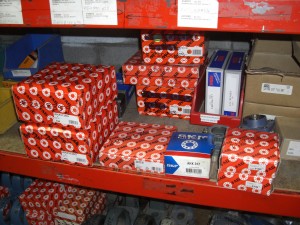 Understanding the definitions used in spare parts inventory management is vitally important.
Understanding the definitions used in spare parts inventory management is vitally important.
For without a common understanding of terms it is difficult to communicate effectively.
Imagine what happens when someone uses a term such as SKU in a conversation or email and the person listening or reading doesn’t understand that term. It is rare for people to just own-up and admit that they don’t understand the term being used.
That’s why, at SparePartsKnowHow.com, we keep and update a glossary fo terms. This to help everyone get better at communicating their needs and intentions in spare parts inventory management.
Stock Keeping Unit (SKU) Definition
Stock Keeping Unit (SKU) is an inventory management term that
identifies and distinguishes a single inventory item from all the other items in that inventory. In other words, it is a way to refer to individual inventory items.
For example, an inventory may consist of 2,000 different types of items – each of which will also be an individual stock keeping unit. Stock keeping unit is not a way to identify individual items of the same type or part.
The term stock keeping unit is often shortened using the acronym SKU.
Sometimes the term SKU is used in reference to the specific unique identifer code used to identify the individual item.
Stock Keeping Unit Explanation
There are several reasons why it is important to identify spare parts inventory items individually as different SKUs:
- It can be used to track the history of the part and from that help you to work on spare parts inventory optimization
- It helps your maintenance team more easily identify individual parts
- When tied to spare parts location information it helps your team more easily locate the parts in your storeroom/warehouse
- It helps your procurement or purchasing team ensure that they are purchasing the same part in future
- It helps ensure that your costs are appropriately allocated and reported
- It simplifies you stock take and cycle count activity
There are a number of different attributes that can be used to identify different SKUs. These are not just limited to physical attributes such as the physical dimensions or color or design or model but can also relate to supply attributes such as the manufacturer or supplier or packaging.
However, for spare parts used for operations and maintenance support it is more typical to identify the SKU by its physical attributes as it is these that matter most when in use. For example, a bearing may be described by its type and physical dimensions without necessarily differentiating between that type and size of bearing from different suppliers.
For information on our spare parts management online training please visit our Pro Level page.
Posted by: Phillip Slater